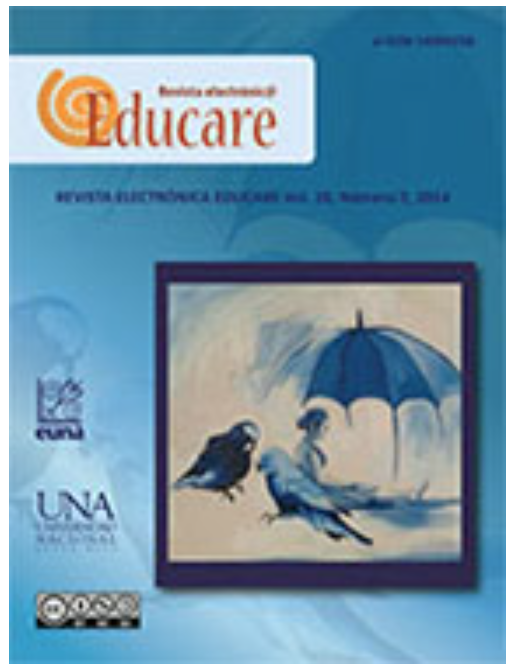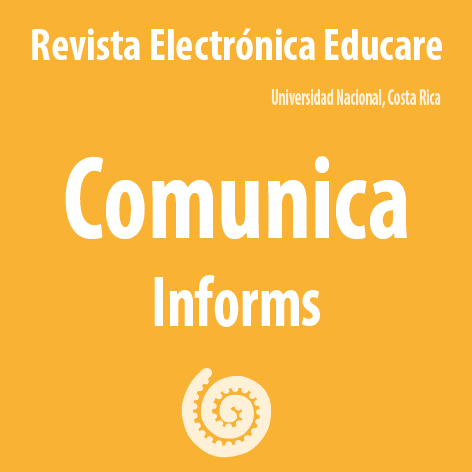Relationship between Affective Dimension and Math Learning
DOI:
https://doi.org/10.15359/ree.18-2.6Keywords:
Attitudes, beliefs, students, teachers, teaching, learning, math.Abstract
Math has become an obstacle to achieve educational goals for a large number of students; thus it has transcended the academic world and has become a cognitive and emotional impairment. What students feel, perceive, believe, and how they act directly influences this. In addition, what teachers feel and perceive, their expectations, beliefs and attitudes towards the discipline also play an important role in how they teach and in the affective dimension of their students. Based on theoretical aspects from various authors, this paper is aimed at addressing some elements regarding the affective dimension, and at showing elements pertaining to teachers and students, and their relationship with math learning and teaching. It was concluded that the role of the affective dimension in math learning must be addressed by math educators in order to understand the process from the perspective of the actors associated with it, both students and teachers, as well as to achieve a change in the discipline by improving the beliefs and attitudes of students and teachers.
References
Akay, H. y Boz, N. (2010). The Effect of Problem Posing Oriented Analyses-II Course on the Attitudes toward Mathematics and Mathematics Self-Efficacy of Elementary Prospective Mathematics Teachers [Actitudes hacia la matemática y autoeficacia en matemáticas de los futuros profesores de matemáticas de primaria]. Australian Journal of Teacher Education, 35(1), 1-75. Recuperado de http://files.eric.ed.gov/fulltext/EJ908190.pdf
Belbase, S. (2010). Images, Anxieties and Attitudes Toward Mathematics [Imágenes, ansiedades y actitudes hacia las matemáticas]. Recuperado de http://files.eric.ed.gov/fulltext/ED513587.pdf
Benken, B. (2005). Investigating the complexities of mathematics teaching: The Role of Beginning Teachers’ Beliefs in Shaping Practice [Investigando las complejidades de la enseñanza de las matemáticas: El papel de las creencias de los docentes principiantes en la conformación de la práctica]. En G. M. Lloyd, M. Wilson, J. L. M Wilkins, & S. L. Benm (Eds.), Proceedings of the 27th annual meeting for the North American Chapter of the International Group of the Psychology of Mathematics Education, USA, 275. [Actas de la 27 reunión anual para el Capítulo del Grupo Internacional de Psicología de la Educación Matemática de América del Norte]. (pp. 1-6). Recuperado de http://citation.allacademic.com/meta/p_mla_apa_research_citation/0/2/4/8/2/p24825_index.html?phpsessid=ui7tgtlc0kv77uc5rvmevv44b3
Bernal, A. (2009). Relación de las actitudes de los estudiantes hacia la matemática antes y después de haber cursado y aprobado los programas de Cálculo diferencial e integral en la Universidad Sergio Arboleda (Tesis de Maestría, Universidad Sergio Arboleda). Colombia, Bogotá.
Cadoche, L. y Pastorelli, S. (2005). Concepciones de los alumnos ingresantes a la universidad acerca de la matemática. Revista Premisa, 7(26), 28-34. Recuperado de http://www.soarem.org.ar/Documentos/26%20Cadoche.pdf
Candia, P. T. (2009). Actitud hacia las matemáticas en alumnos de ingeniería de tercero y quinto semestres del ITESCA. Memoria X Congreso Nacional de Investigación Educativa. Área 5: Educación y Conocimientos Disciplinares. Recuperado de http://www.comie.org.mx/congreso/memoriaelectronica/v10/pdf/area_tematica_05/ponencias/0310-F.pdf
Chandía, E., Quiroga, F. y Ulloa, R. (2006). Creencias de los alumnos y profesores de 1er año de enseñanza media de la intercomuna de Concepción asociadas a la asignatura de matemática. Ponencia presentada en la XIII Jornada de Investigación de Educación Matemática, Concepción, Chile.
Chaves, E., Castillo , M. y Gamboa (abril, 2008). Creencias de los estudiantes en los procesos de aprendizaje de las matemáticas. Cuadernos de Investigación y Formación en Educación Matemática, 3(4), 29-44. Recuperado de http://www.revistas.ucr.ac.cr/index.php/cifem/article/view/6906/6592
De Faria, E. (2008). Creencias y matemáticas. Cuadernos de Investigación y Formación en Educación Matemática, 3(4), 9-27. Recuperado de http://www.revistas.ucr.ac.cr/index.php/cifem/article/view/6900/6586
Díaz, F. y Hernández, G. (2010). Estrategias docentes para un aprendizaje significativo. México: McGraw-Hill.
Ernest, P. (1988). The Impact of Beliefs on the Teaching of Mathematics [El impacto de las creencias en la enseñanza de las matemáticas]. En P. Ernest (Ed.), Mathematics Teaching: The State of the Art [Enseñanza de las matemáticas: El estado del arte] (pp. 249–254). London: Falmer Press. Recuperado de http://people.exeter.ac.uk/PErnest/impact.htm
Estrada, M. A. (2002). Análisis de las actitudes y conocimientos estadísticos elementales en la formación del profesorado (Tesis doctoral). Universitat Autónoma de Barcelona. Barceloan, España. Recuperado de http://www.tesisenred.net/bitstream/handle/10803/4697/maer1de3.pdf?sequence=1
Gil, N., Blanco, L. y Guerrero, E. (junio, 2005). El dominio afectivo en el aprendizaje de las matemáticas. Una revisión de sus descriptores básicos. Unión. Revista Iberoamericana de Educación Matemática, 2, 15-32. Recuperado de http://www.fisem.org/www/union/revistas/2005/2/Union_002_004.pdf
Gil, N., Guerrero, E. y Blanco, L. (enero-abril, 2006). El dominio afectivo en el aprendizaje de las matemáticas. Revista Electrónica de Investigación Psicoeducativa, 4(1), 47-72. Recuperado de http://www.investigacion-psicopedagogica.org/revista/articulos/8/espannol/Art_8_96.pdf
Gómez, I. M. (2000). Matemática emocional. Los efectos en el aprendizaje matemático. Madrid: Narcea.
Hernández, G. (febrero, 2011). Estado del arte de creencias y actitudes hacia las matemáticas. Cuadernos de Educación y Desarrollo, 3(24). Recuperado de http://www.eumed.net/rev/ced/24/ghs.pdf
Howe, K. y Berv, J. (2002). Constructing constructivism, Epistemological and Pedagogical [Construyendo el constructivismo epistemológico y pedagógico]. En D. C. Phillips (Ed.), Construtivism in Education: Opinions and Second Opinions on Controversial Issues [Constructivismo en educación: Opinión y segundas opiniones sobre cuestiones controvertidas] (pp. 19-40). Estados Unidos: The Society Margareth Early.
Jensen, E. (2010). Cerebro y aprendizaje. Competencias e implicaciones educativas. Madrid: Narcea Ediciones.
Lamas, H. (enero-diciembre, 2010). Una mirada actual al aprendizaje de las matemáticas. Revista de Psicología, 12(1), 259-328. Recuperado de http://revistas.concytec.gob.pe/pdf/rp/v12n1/a12v12n1.pdf
Lazim, M. A., Abu, M. T. y Wan, W. A. (2004). The Statistical Evidence in Describing the Students’ Beliefs about Mathematics [La evidencia estadística en la descripción de las creencias de los estudiantes sobre las matemáticas]. International Journal for Mathematics Teaching and Learning, 1-17. Recuperado de http://www.cimt.plymouth.ac.uk/journal/lazimetal.pdf
Liljedahl, P. (2005). Re-Educating Preservice Teachers of Mathematics: Attention to the Affective Domain [Reeducar a futuros profesores de matemáticas: Atención al dominio afectivo]. En G. M. Lloyd, M. Wilson, J. L. M Wilkins, & S. L. Benm (Eds.), Proceedings of the 27th annual meeting for the North American Chapter of the International Group of the Psychology of Mathematics Education, USA. [Actas de la 27 reunión anual para el Capítulo del Grupo Internacional de Psicología de la Educación Matemática de América del Norte] (pp. 1-7). Recuperado de http://citation.allacademic.com/meta/p_mla_apa_research_citation/0/2/4/6/4/p24647_index.html
Martínez, O. J. (2008). Actitudes hacia la matemática. Sapiens, 9(1), 237-256. Recuperado de http://www.redalyc.org/articulo.oa?id=41011135012
McLeod, D. y McLeod, S. (2002). Synthesis-Beliefs and Mathematics Education: Implications For Learning, Teaching, and Research [Síntesis-creencias y educación matemática: Implicaciones para el aprendizaje, enseñanza e investigación]. En G. Leder, E. Pehkonen, & G. Törner (Eds.), Beliefs: A Hidden Variable in Mathematics Education? [Creencias: Una variable escondida en educación matemática] (pp. 115-123). Londres: Kluwer Academic Publishers.
Mewborn, D. y Cross, D. I. (2007). Mathematics Teachers’ Beliefs about Mathematics and Links to Students’ Learning [Creencias de los profesores de matemáticas sobre las matemáticas y las relacionadas con el aprendizaje de los estudiantes]. En W. G. Martin, M. E. Strutchens, & P.C. Elliott (Eds.), The Learning of Mathematics. 69th Yearbook of the National Council of Teachers of Mathematics [El aprendizaje de las Matemáticas. 69 Anuario de la Consejo Nacional de Profesores de Matemáticas] (pp. 259-269). Estados Unidos: Reston, VA.
Mora, F. y Barrantes, H. (2008). ¿Qué es matemática? Creencias y concepciones en la enseñanza media costarricense. Cuadernos de Investigación y Formación en Educación Matemática, 3(4), 71-81. Recuperado de http://revistas.ucr.ac.cr/index.php/cifem/article/view/6901/6587
Pantziara, M. y Philippou, G. (2011). Fear of Failure in Mathematics. What are the Sources? [Miedo a las matemáticas ¿Cuáles son las causas? Trabajo presentado en Seventh Congress of the European Society for Research in Mathematics Education University of Rzeszów, Poland. Recuperado de http://www.cerme7.univ.rzeszow.pl/WG/8/CERME%207_WG8_Pantziara.pdf
Parra, H. (marzo, 2005). Creencias matemáticas y la relación entre actores del contexto. Revista Latinoamericana de Investigación en Matemática Educativa, 8(1), 69-90. Recuperado de http://www.redalyc.org/articulo.oa?id=33508104
Pezzia, M. y Di Martino, P. (2011). The Effect of a Teacher Education Program on Affect: the Case of Teresa and PFCM [El efecto de un programa de formación docente en el afecto: El caso de Teresa y PFCM]. Trabajo presentado en la Seventh Congress of the European Society for Research in Mathematics Education University of Rzeszów, Poland. Recuperado de http://www.cerme7.univ.rzeszow.pl/WG/8/CERME%207_WG8_Pezzia.pdf
Ponce, S., Martínez, G. y Zuriaga, F. (2008). Creencias y estereotipos: La dimensión afectiva y su influencia en matemática. Memorias del VI Congreso Argentino de Enseñanza de la Ingeniería (VI CAEDI). Ciudad de Salta, Argentina.
Sánchez, D. (2008). Las creencias en la matemática. En Memorias VI Coloquio de Experiencias Educativas en el contexto universitario (pp. 1-12). La Habana: Editorial Universitaria. Recuperado de http://revistas.mes.edu.cu/greenstone/collect/repo/import/repo/20090319-u/9789591610010028.pdf
Solé, I. (1999). Disponibilidad para el aprendizaje y sentido del aprendizaje. En C. Coll, E. Martín, T. Mauri, M. Miras, J. Onrubia, I. Solé y A. Zabala (Eds.), El constructivismo en el aula (10ª ed., pp. 25-46). Barcelona: Graó.
Solé, I. y Coll, C. (1999). Los profesores y la concepción constructivista. En C. Coll, E. Martín, T. Mauri, M. Miras, J. Onrubia, I. Solé y A. Zabala (Eds.), El constructivismo en el aula (10ª ed., pp. 7-23). Barcelona: Graó.
Thompson, A. (1992). Teachers’ Beliefs and Conceptions: A Synthesis of the Research [Creencias de los profesores y concepciones: Una síntesis de la investigación]. En D. A. Grouws (Ed.), Handbook of Research in Mathematics Teaching and learning [Manual de investigación en la enseñanza y aprendizaje de las matemáticas] (pp. 127-146). New York, NY: Macmillan.
Downloads
Additional Files
Published
How to Cite
Issue
Section
License
1. In case the submitted paper is accepted for publication, the author(s) FREELY, COSTLESS, EXCLUSIVELY AND FOR AN INDEFINITE TERM transfer copyrights and patrimonial rights to Universidad Nacional (UNA, Costa Rica). For more details check the Originality Statement and Copyright Transfer Agreement
2. REUTILIZATION RIGHTS: UNA authorizes authors to use, for any purpose (among them selfarchiving or autoarchiving) and to publish in the Internet in any electronic site, the paper´'s final version, both approved and published (post print), as long as it is done with a non commercial purpose, does not generate derivates without previous consentment and recognizes both publisher's name and authorship.
3. The submission and possible publication of the paper in the Educare Electronic Journal is ruled by the Journal’s editorial policies, the institutional rules of Universidad Nacional and the laws of the Republic of Costa Rica. Additionally, any possible difference of opinion or future dispute shall be settled in accordance with the mechanisms of Alternative Dispute Resolution and the Costa Rican Jurisdiction.
4. In all cases, it is understood that the opinions issued are those of the authors and do not necessarily reflect the position and opinion of Educare, CIDE or Universidad Nacional, Costa Rica. It is also understood that, in the exercise of academic freedom, the authors have carried out a rogorous scientific-academic process of research, reflection and argumentation thar lays within the thematic scope of interest of the Journal.
5. The papers published by Educare Electronic Journal use a Creative Commons License:














 The articles published by Educare Electronic Journal can be shared with a Creative Commons License:
The articles published by Educare Electronic Journal can be shared with a Creative Commons License: 



